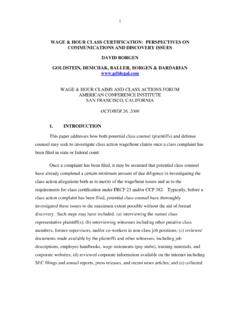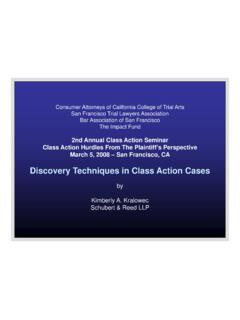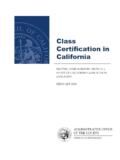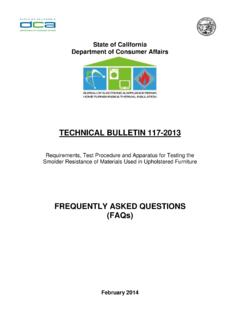Transcription of TOLLING: THE TOLLING RULE AND SUCCESSIVE CLASS …
1 TOLLING : THE AMERICAN PIPE TOLLING RULE ANDSUCCESSIVE CLASS ACTIONSR honda Wasserman*Abstract:Timing is everything. Even the most meritorious lawsuit will bedismissed if the statute of limitations has run on the plaintiff s claim. Inclass action litigation, this hurdle is particularly daunting. Supreme Courtprecedent makes clear that if a CLASS action complaint is timely filed, thenthe claims of all CLASS members are deemed timely. Likewise, if a motionto certify the CLASS is denied, absent CLASS members may seek to intervenein the pending action or to file individual actions and either way, the statuteof limitations is tolled from the date of filing of the CLASS action complaintuntil denial of the motion to certify.
2 But what if the absent CLASS membersseek to present their claims collectively in the context of a SUCCESSIVE classaction? Is the statute of limitations tolled in this context as well?Intuitively, one might think that the same policies that justify TOLLING inthe first two situations also justify TOLLING in the SUCCESSIVE CLASS actioncontext. Yet a majority of the federal Courts of Appeals that haveaddressed this issue have denied TOLLING in the SUCCESSIVE CLASS actioncontext. Given the volume of CLASS action litigation, the lack of control thatabsent CLASS members have over the timing of the certification decision,and the devastating effect the statute of limitations may have on theirclaims, it behooves us to understand why the courts have resolved thetolling issue for SUCCESSIVE CLASS actions differently and whether suchdifferential treatment is Article analyzes three sets of policies that have influenced thecourts in this context: the policies underlying statutes of limitations; thepolicies underlying Rule 23; and the policies underlying preclusiondoctrine.
3 A careful analysis of these competing policies calls the majorityrule into question in two common circumstances: where certificationinitially was denied because of a problem with the CLASS representative orbecause of a problem with the CLASS itself that the SUCCESSIVE CLASS actionseeks to remedy. Only where there is a problem with the CLASS itself and the * Professor of Law, University of Pittsburgh School of Law. , Cornell University,1980; , Yale Law School, 1983. I would like to thank Joel Friedman, Sam Issacharoff, JulesLobel, Margaret Mahoney, George Rutherglen, Joan Steinman, and Tobias Barrington Wolff fortheir invaluable comments on an earlier draft of this Article. I am grateful to Christina Yaeger forher diligent research assistance.
4 I dedicate this Article with great pride and much love to Eric andScott Wasserman Stern on the occasion of their B nai LAW REVIEW[Vol. 58successive CLASS action fails to address that problem does the combinationof relevant policies counsel against TOLLING .. 805 FIRST RING: THE STATUTE OF LIMITATIONS POLICIES.. Introduction to Statutes of Limitations.. Statute of Limitations Policies.. 811 SECOND RING: THE RULE 23 POLICIES ANDTOLLING IN THE CLASS ACTION CONTEXT.. Introduction to TOLLING .. 8131. TOLLING Statutes .. 8132. Saving Statutes .. 8153. Equitable TOLLING Principles .. in the CLASS Action Context.. 8191. The Rule 23 Policies .. 8192. The Supreme Court s Balance of the Statuteof Limitations Policies and the Rule 23 Policies.]
5 Pipe & ConstructionCo. v. Utah (1974) .. , Cork & Seal Parker (1983) .. 8263. The Lower Courts Balance of the Statuteof Limitations Policies and the Rule 23 Policies .. 828 IV. THE THIRD RING: THE PRECLUSION POLICIES ANDTOLLING IN THE SUCCESSIVE CLASS ACTION CONTEXT.. Preclusion Policies.. Application of Preclusion Doctrine in theSuccessive CLASS Action Context.. in the SUCCESSIVE CLASS Action Context:The Lower Courts Balance of the Three Setsof Policies.. 8421. The Majority View: No TOLLING .. 8422. The Minority View: TOLLING in Limited Circumstances .. 844 V. A RECOMMENDED ANALYSIS.. of the Statute of Limitations Policies.. of the Rule 23 Policies.. 8522006] TOLLING : THE AMERICAN PIPE TOLLING RULE AND SUCCESSIVE CLASS of the Preclusion Policies.
6 854 VI. CONCLUSION.. 858 Though rarely the subject of sustained scholarly attention, the lawconcerning statutes of limitations fairly bristles with subtle, intricate, oftenmisunderstood issues .. 1I. INTRODUCTIONT iming is everything. Even the most meritorious lawsuit will bedismissed if the statute of limitations has run on the plaintiff s claim. Itseems such a simple hurdle to overcome: just file a complaint (or serve thedefendant) within the limitations period. But in the context of CLASS actionlitigation, the statute of limitations hurdle may be more that a CLASS action complaint is timely filed. What if classcertification is denied after the statute of limitations has run and the absentclass members then seek to press their claims?
7 In determining whethertheir claims are time-barred, does it matter if the absent CLASS membersproceed individually or initiate a SUCCESSIVE CLASS action?For more than thirty years, it has been well accepted that the filing ofa CLASS action complaint tolls2 the statute of limitations applicable to theclaims of absent CLASS members. In 1974 in American Pipe & ConstructionCo. v. Utah,3 the Supreme Court held that the statute of limitations issuspended for the period between the filing of a CLASS action complaint andthe denial of a motion to certify the CLASS when, upon denial of classcertification for a lack of numerosity, absent CLASS members seek tointervene in the action to press their individual Likewise, in 19831.
8 Wolin v. Smith Barney, Inc., 83 847, 849 (7th Cir. 1996).2. According to the Supreme Court:[T]he word TOLLING [means] that during the relevant period, the statute oflimitations ceases to run. TOLLING effect refers to the method of calculating theamount of time available to file suit after TOLLING has ended. The statute oflimitations might merely be suspended; if so, the plaintiff must file within theamount of time left in the limitations period. If the limitations period is renewed,then the plaintiff has the benefit of a new period as long as the original. It is alsopossible to establish a fixed period such as six months or one year during whichthe plaintiff may file suit, without regard to the length of the original limitationsperiod or the amount of time left when TOLLING v.
9 Fumero Soto, 462 650, 652 (1983).3. 414 538 (1974). at 552-53. If state law supplies the statute of limitations, then state law ordinarilydetermines the particular TOLLING effect of a prior CLASS action. See Chardon, 462 at 654, 661-62(holding that Puerto Rican law, under which the one-year statute of limitations period began anew806 FLORIDA LAW REVIEW[Vol. 58in Crown, Cork & Seal Co. v. Parker,5 the Court held that the statuteof limitations is tolled when, upon denial of CLASS certification, absentclass members decline to intervene in the putative CLASS action but seekinstead to initiate their own independent But what if, upondenial of certification, absent CLASS members decline tointervene and decline to initiate their own individual lawsuits, butinstead seek to press their claims in the context of asuccessive CLASS action initiated by a new CLASS representative?)]
10 7 following a denial of CLASS certification, governed a section 1983 action filed in federal court inPuerto Rico). See also Kathleen L. Cerveny, Note, Limitation TOLLING When CLASS Status Denied:Chardon v. Fumero Soto and Alice in Wonderland, 60 NOTRE DAME L. REV. 686, 687 (1985)(criticizing the Chardon Court for improperly narrow[ing] the scope of American Pipe sinterpretation of Rule 23 and expand[ing] the potential for confusion in CLASS action litigation ).5. 462 345 (1983). at Courts have also had to consider whether the statute of limitations is tolled during thependency of a CLASS action if a new plaintiff seeks to join the existing suit, through intervention orotherwise, and to represent the CLASS upon a determination that the original putative representativefails to present typical claims, proves to be an inadequate representative, or lacks standing.










